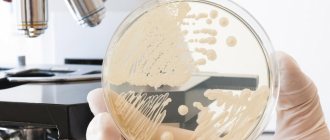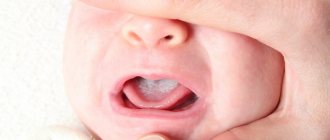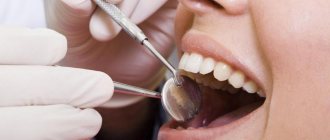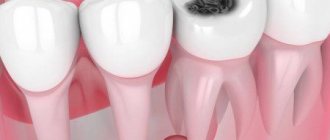Laryngomycosis is a chronic inflammatory disease of the larynx, one of the etiological factors of which is fungal flora. According to domestic and foreign literature, laryngomycosis accounts for 5 to 18% of all mycoses of the ENT organs. The main causative agents of laryngomycosis are yeast-like fungi of the genus Candida.
(up to 80%), mold mycoses caused by fungi of the genera
Aspergillus
,
Penicillium
,
Scopulariopsis
,
Cephalosporum
,
Zygosaccharomyces
,
Mucor common
[1–5].
Currently, more and more reports are appearing in foreign literature about isolated cases of laryngomycosis, recorded mainly in patients with various immunodeficiency conditions [2, 6-8]. For the treatment of laryngomycosis, systemic antifungal drugs (fluconazole, itraconazole) are mainly used, and the duration of therapy varies from 1 week to several months. Attention is also paid to the correction of risk factors, for example, stopping the use of topical inhaled glucocorticosteroids [7-10].
Therapy of mycotic chronic laryngitis presents known difficulties; there is no single treatment algorithm. The difficulty of using drugs for local antimycotic therapy is due to the anatomical and functional characteristics of the affected organ.
The purpose of the study is to develop an algorithm for the treatment of laryngomycosis.
1.General information
In order not to be interrupted by terminological references in the future, we will stipulate the following as a kind of preamble.
Opportunistic is an infection that occurs, literally, “at an opportunity,” “if possible,” i.e. under a certain combination of conditions favorable for the opportunistic microorganism. In turn, conditional pathogenicity implies asymptomatic parasitism or commensalism (harmless coexistence) of any microculture in the host’s body - as long as the host is healthy and immunocompetent - and the ability of this culture to undergo rapid pathogenic activation with a weakening of the immune defense, a significant change in the structure of the microbiome and some other circumstances.
Mycosis is a systemic infection by fungal cultures. Candidiasis is an extremely widespread (in fact, the most common) variant of mycosis, caused by yeast-like opportunistic fungi of the numerous genus Candida, most often Candida ablicans (the causative agent, in particular, of urogenital “thrush”).
Thus, pharyngeal candidiasis is an opportunistic mycosis caused by the activation of Candida and predominantly localized in one of the ENT organs.
A must read! Help with treatment and hospitalization!
Results and discussion
Treatment of patients with laryngitis, even before receiving the results of mycological examination, began with anti-inflammatory therapy. The nature of therapy depended on the form of chronic laryngitis: catarrhal, atrophic or hyperplastic.
All patients received alkaline inhalations with degassed mineral water (Essentuki 4) or 0.9% sodium chloride solution 1 to 3 times a day for 10 minutes. According to indications, desensitizing, decongestant, mucolytic, anti-inflammatory and symptomatic therapy was carried out. Actions were taken to reduce trauma to the vocal folds: vocal stress was reduced and antitussives were prescribed. Much attention was paid to the maximum possible elimination of predisposing factors of the disease (anti-reflux therapy, correction of glycemia, replacement of dentures and proper care for them, limiting smoking, etc.), treatment of concomitant ENT pathology, as well as creating conditions for a physiological type of phonation.
The basis of complex therapy for patients with laryngomycosis was antimycotic therapy, which was prescribed after receiving the results of a mycological study in accordance with the isolated pathogen and its sensitivity to antimycotics. Antimycotic drugs of both systemic and local action were used.
For mold mycosis, itraconazole was prescribed at a daily dose of 100-200 mg, for candidiasis - fluconazole at a dose of 50-150 mg. The dose of the drug was chosen depending on the severity of inflammation of the laryngeal mucosa and the titer of the resulting pathogen. Thus, with a fungal infection titer of more than 1.0·106 CFU/ml (abundant or massive growth of microorganisms), 200 mg of itraconazole or 150 mg of fluconazole per day were prescribed. In addition, when prescribing antifungal therapy, the patient’s age, body weight and biochemical blood test parameters were taken into account. In patients with reduced renal function, chronic heart failure or liver pathology, as well as in the elderly, the dose of drugs was reduced, and in patients with increased body weight it was increased based on a daily dose of no more than 3 ml/kg/day for fluconazole and no more than 400 mg/day for itraconazole. . The duration of therapy with systemic antimycotics was at least 21 days.
Local antimycotic therapy was carried out using inhalations with a 0.01% solution of benzidylmethyl-myristoylaminopropylammonium for 10 minutes, 2 times a day. The antimycotic amphotericin B was also used by inhalation, a suspension of which was prepared immediately before use by dissolving the contents of the bottle (lyophilized powder 50,000 units) in 10 ml of sterile water for injection. The duration of inhalation was 15 minutes, the frequency was 1 time per day.
When mycosis of the larynx and pharynx was combined, a 1% solution of clotrimazole was used for local treatment of the pharynx in the form of lubricants of the mucous membrane of the oral cavity and pharynx 3-4 times a day. Nystatin was also used as local therapy, the tablet form of which was adapted for use in otorhinolaryngology - a suspension was prepared immediately before use by mixing two crushed tablets of 500,000 units each with 100 ml of water. Patients gargled with the resulting suspension, followed by swallowing the drug 5 times a day.
Patients with a hyperplastic form of laryngitis, after a course of anti-inflammatory therapy, according to indications, also underwent surgical treatment - removal of the hyperplastic mucous membrane of the vocal folds, and in some cases, biopsy of altered areas of the mucous membrane of the larynx.
In 2 patients - 1 man (35 years old) and 1 woman (36 years old) with hyperplastic and catarrhal forms of laryngitis, damage to the larynx by mold fungi Aspergillusniger
. Combined (systemic and local) antifungal treatment in these patients included itraconazole 100 mg/day for 21 days, inhalation with amphotericin B (50,000 units) once a day for 7 days, then inhalation of 0.01% benzidylmethylmyristoylaminopropylammonium solution 2 times a day day - 14 days. As a result of a 3-week course of treatment in a patient with a catarrhal form of laryngomycosis, it was possible to achieve normalization of the laryngoscopic picture and the results of repeated mycological studies, while in a patient with a hyperplastic form a significant improvement was achieved, however, during the control mycological study, the fungal flora remained in a clinically significant titer, therefore, a second course of combination therapy was carried out after 2 weeks for 10 days. After a repeated course, it was possible to achieve stable remission of chronic laryngitis and negative results of mycological studies.
As a result of treating three groups of patients with candidal laryngitis, the best results were obtained in group C, in which patients received antifungal therapy with drugs of both local and systemic action, and the clinical result was achieved already on the 21st day of treatment. Clinical effectiveness of treatment was achieved in 79.4% of patients. In group B, where patients received only systemic antifungal therapy for 28 days, a positive effect of treatment was achieved in 45.2% of cases, while in group A, where only local treatment with antifungals was used, the results were the most unsatisfactory: a positive result was achieved after a course of treatment for 28 days only in 21.2% of patients.
After completion of the course of treatment, patients were observed over time and re-examined (clinical and laboratory) on the 60th, 90th, 180th day from the start of treatment and then after 9, 12, 18 and 24 months. In 21% of patients, we detected a recurrence of the disease within 3–12 months, which required a repeat course of combined antifungal therapy.
2. Reasons
In the clinic of infectious diseases, the main and universal cause, as well as a risk factor, is weakened immunity - no matter what causes the decrease in the body’s natural defenses. However, since the mid-twentieth century, another factor has appeared (and continues to gain strength), which is extremely “convenient” and favorable specifically for fungi. We are talking about antibiotics, which are often used as self-medication, in irrational doses, for too long a course, or in situations where antibacterial drugs are objectively not needed at all.
Suppression or destruction of bacterial microflora, including those that perform protective functions as a symbiont (it should be noted here that broad-spectrum antibiotics are not named this way by chance), disrupts the optimal balance in the microecological system of the human body, and fungi begin to occupy the vacated niche. According to modern estimates, fungal infections of the oral cavity and pharynx account for 40% of all mycoses of the mucous membranes. In the total volume of recorded oropharyngeal fungal invasion, candidiasis accounts for 90-95%. The remaining cases are caused by aspergillus, penicillium and other fungi, as well as their combinations (mixed pharyngomycosis).
The importance of risk factors such as diabetes mellitus, AIDS (every tenth patient with acquired immunodeficiency syndrome dies from fungal infections), smoking, allergic hypersensitivity, long-term use of hormone-containing anti-inflammatory drugs, oral sex with a carrier of genital candidiasis, as well as intestinal dysbiosis has been reported.
Visit our Otolaryngology (ENT) page
Patients and methods
In the Department of ENT Pathology of Children, State Budgetary Healthcare Institution “NIKIO named after. L.I. Sverzhevsky" DZM on the basis of the State Budgetary Institution "DGKB No. 9 named after. G.N. Speransky" DZM examined and treated 306 children with chronic tonsillitis and 402 children with chronic adenoiditis aged 2 to 16 years.
The diagnostic algorithm for examining children with fungal infections of the pharynx included: collection of complaints and medical history, otorhinolaryngological examination, endoscopic examination of the nose, nasopharynx and oropharynx, microbiological diagnostics (bacteriological and mycological).
When collecting an anamnesis of the disease, attention was paid to the child’s complaints, previous viral infections, and the presence of chronic diseases, in particular diabetes mellitus; features of the course and frequency of recurrence of the inflammatory process of the pharyngeal and palatine tonsils. The collection of medical history included anamnesis of antibacterial, corticosteroid and immunosuppressive therapy, since with long-term use of these drugs immunosuppression occurs, leading to the activation of a fungal infection.
During an objective examination, attention was paid to the condition of the nasal mucosa; for the presence and nature of pathological discharge in the common nasal passage; for the presence or absence of changes in the mucous membrane of the oropharynx, palatine tonsils, regional lymph nodes (submandibular, anterior cervical, posterior cervical).
When conducting an endoscopic examination of the nasopharynx, we assessed not only the shape, size and location of the pharyngeal tonsil in relation to the paranasal structures, but also the absence or presence of signs of inflammation of the pharyngeal tonsil (swelling, hyperemia, smoothness of the grooves, the presence of secretions, the nature and extent of pathological overlays).
When collecting pathological material from the surface of the pharyngeal tonsil in children, we used a method developed by us, which allows us to take material directly from the pharyngeal tonsil, excluding contamination from adjacent paranasal structures (priority certificate for the issuance of a RF patent for an invention No. 2011107242). The use of endoscopic control during the selection of pathological material made it possible to visualize and select the exact localization of the pharyngeal tonsil site. When carrying out this method, a rigid endoscope with 0° optics was used.
To determine the prevalence of fungal inflammation, samples were taken from different loci (from the palatine tonsils, from the nasopharynx and from the surface of the mucous membrane of the posterior pharyngeal wall).
Laboratory microbiological diagnostics were carried out in two directions: microscopy of pathological discharge from various loci of the pharynx and nasopharynx, as well as cultural research methods - inoculation of pathological discharge on liquid and solid nutrient media, followed by counting fungal colonies and determining the growth rate. The preparations were stained using the Gram method, and the calcofluor white staining method was also used. When conducting a cultural study, Sabouraud's medium was used to identify the fungus. Species identification was carried out using standard API 20 test systems (bioMerieux, France).
The sensitivity of fungi to antifungal drugs was determined using the disk diffusion method to modern antifungal drugs: fluconazole, ketoconazole, clotrimazole, itraconazole, voriconazole and amphotericin.
To identify the bacterial flora, 5% blood agar, 10% yolk-salt agar, and Endo medium were used as nutrient media. After isolating a pure culture, the sensitivity of bacteria to antibiotics was determined using the disk diffusion method.
To exclude side effects of systemic antifungal drugs, on the 5th day of taking antifungal therapy, a biochemical blood test was performed (monitoring liver enzymes: ALT, AST, alkaline phosphatase).
3. Symptoms and diagnosis
As a rule, pharyngeal candidiasis occurs with few symptoms or with moderate severity of clinical manifestations. Typical symptoms include inflammation of the tonsils and mucous membranes, a dirty white coating, low-grade fever, mild malaise, discomfort or pain when swallowing.
Granulomatous, atrophic, hyperplastic, erosive-ulcerative forms are relatively less common, requiring differential diagnosis, in particular, with tuberculosis.
Candidiasis of the pharynx is easily chronic and occurs, as a rule, in waves.
The prognosis worsens when the mycotic infection spreads to adjacent and internal organs.
If oropharyngeal candidiasis is suspected, a smear is taken from the affected surface, then a culture is performed on a nutrient medium; Recently, genetic identification (PCR) and serological tests (detection of specific antibodies) have been increasingly used.
About our clinic Chistye Prudy metro station Medintercom page!
Common Oral Yeast Infection Symptoms
Experts say that in some cases, candidiasis, or a yeast infection in the mouth or throat, goes away without symptoms, making it difficult to detect the infection.
In other patients, it causes a burning or itching sensation in the throat or mouth. If the fungus is localized in the throat, a person may experience difficulty swallowing or a feeling of a stuck “lump.” In some patients, oral candidiasis is easily identified due to visible symptoms. For example, the development of a yeast infection is usually indicated by a white coating and lesions on the tongue or roof of the mouth, although they can be caused by other diseases. In addition, the presence of candidal stomatitis is indicated by cracks and redness in the corners of the mouth, as well as the formation of a smooth red area in the center of the tongue.
Who is at risk?
According to the National Otolaryngology Medical Association, oral yeast infections are becoming more common. Candidal stomatitis develops especially often in people with weakened immune systems, newborns and the elderly.
Thus, in AIDS patients, the prevalence of candidiasis ranges from 21.9% to 74%, according to researchers from the Medical University. Gorky.
Diagnosis and treatment of infection
If you or someone you know is experiencing symptoms of a yeast infection in your throat or mouth, it is best to see a doctor. The dentist will examine your mouth, take a swab from your throat, and make a diagnosis.
Candida fungi in their mouths
. That is why, in addition to the results of the smear, the doctor will focus on the presence of symptoms of infection.
If the disease is confirmed, you will be prescribed a fairly simple treatment. Antifungal drugs are usually used in the form of tablets, syrup or capsules.
Prevention measures
Preventive measures can help you avoid getting an oral yeast infection. First of all, it is necessary to maintain proper oral hygiene. This includes brushing your teeth twice a day using fluoride toothpaste. People at risk for candidiasis should visit the dentist regularly to monitor their oral health.
In between visits, it is recommended to study information about the symptoms of a yeast infection in the throat or mouth, as well as what to do if you notice one.
Treatment and prevention
Traditional antibiotic therapy for thrush not only does not bring results, but can also intensify the manifestation of the disease.- It is necessary to diagnose and treat the underlying process that led to decreased immunity. Without this, fungi in the child’s throat will persist for a long time, regardless of the therapy performed.
- Mushrooms of the genus Candida are afraid of an alkaline environment, so lubrication and gargling with a soda solution are successfully used locally.
- Depending on the severity of the process, the pediatrician prescribes antiseptic solutions.
- In children, at the first symptoms of candidiasis, local treatment is usually sufficient. Only chronic forms, when the spread of fungi throughout the body is proven, require the use of general antifungal drugs.
The determination of treatment tactics and the choice of drugs in the treatment of thrush in children should be carried out only by a pediatrician.
Prevention of fungal infections of the throat is aimed at maintaining hygiene standards and increasing the protective properties of the body. Children should eat a balanced diet (deficiency of vitamins and protein reduces immunity), follow a daily routine, and avoid excessive physical activity and stress. When caring for a newborn, it is important to follow all hygiene rules.
When children become ill, you should not self-medicate, especially through the unjustified use of antibiotics. If long courses of antibiotics or chemotherapy are necessary, antifungal drugs are taken as prescribed by a doctor.











